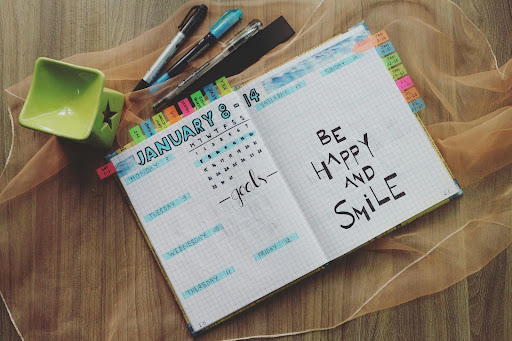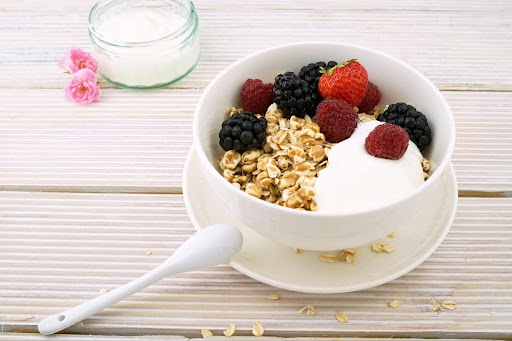
Let’s face it—trying to eat “healthy” can feel overwhelming. Not because you don’t want to, but because life moves fast. Work meetings run long, the fridge is half-empty, and suddenly it’s 8 PM, and you’re eating whatever’s easy.
For a long time, I thought eating well-meant following some perfect plan with no mistakes, no missed meals. But that kind of thinking never lasted.
What finally worked? Looking at my daily rhythm instead. When I eat. What I reach for when I’m tired.
Turns out, your routine has more influence on your food choices than willpower ever will. And once you shift a few small habits, things start to feel easier. More natural.
So here are five realistic habits that helped make my meals a little more nourishing and a lot less stressful. No big overhauls. Just steady changes that actually stick.
1. Start Your Day With a Nutrient-Forward Anchor Meal
Why Morning Choices Matter
Breakfast really does shape the tone of your day. I didn’t always buy into that, figuring a delicious single-serve coffee pod was enough to get me started. But most days, by 11 AM, I’d be starving and reaching for something quick. Usually something sweet.
What you eat in the morning isn’t just about energy. It’s about how steady you feel. How focused you are.
A breakfast with a little protein, some fiber—maybe eggs and avocado, or a smoothie with Greek yogurt and greens—can help you stay on track without feeling like you’re trying so hard. And just like a good breakfast sets the tone internally, using the body wash in the shower can do the same externally—helping you feel refreshed, energized, and ready to take on the day.
“It’s incredibly important to start your day off right nutritionally,” says Rachel Gargano, MS, RD, CSSD, CBS – Chief Registered Dietitian at Live it Up. “Not only does this fuel your body and brain for your busy day—and help prevent cravings later on—but it also sets your intention.”
Once I started making a real breakfast (nothing fancy, just oatmeal with peanut butter and berries), I stopped feeling so scattered.
Fewer cravings. More energy. It felt like I was giving myself a foundation to work from, instead of playing catch-up by lunchtime.
What’s an Anchor Meal?
Everyone’s got that one meal they rely on. The one that keeps things steady, no matter how chaotic the day gets. That’s your anchor meal.
For some people, it’s eggs and veggies. For others, it’s a smoothie they can blend half-asleep—maybe one with greens powder tossed in for a quick hit of vitamins.
Whatever it is, it’s less about the recipe and more about the rhythm. That one meal you can count on, without having to think about it.
What did I learn? It doesn’t have to be anything profound. Some days it’s just a boiled egg and a handful of cherry tomatoes. Other days, a quick yogurt parfait.
As long as it’s something you come back to and gives your morning a solid nutritional foundation.
2. Schedule Your Meals (and Snacks) Like Meetings
Why Meal Timing Is a Game-Changer
Have you ever skipped lunch without meaning to only to find yourself suddenly you’re starving and reaching for whatever’s closest? Yeah. Been there.
When your eating schedule’s all over the place, your hunger signals get out of sync fast. And that’s when the cravings hit hardest.
What helped me was treating meals a little more like calendar events. Not strict, just…expected. Breakfast around 7:30. Lunch by 12:30. A snack in the afternoon. Dinner before it’s too late.
It gave my body something to rely on. Fewer crashes. Fewer random candy bars at 4 PM.
I used to blow past lunch without even realizing it, especially on busy days. Then I’d overcompensate at dinner and wonder why I felt off.
Now, I block out fifteen minutes, even if it’s just a desk salad. It’s not about being perfect. It’s about building some rhythm into the chaos. And honestly? It works.
How Routines Beat Decision Fatigue
Figuring out when to eat can feel just as exhausting as figuring out what to eat. Especially on days when your brain’s already juggling too much. But once I gave my meals a loose schedule, it was one less thing to think about.
And that little bit of structure? It helps. A lot. Especially if you’re someone managing work calls, pickups, appointments… all of it.
Just knowing I’ve got a snack waiting at 3 (something simple like an apple with almond butter) keeps me from wandering toward the vending machine.
What also helps? Picking a couple of go-to snacks for the week. I usually toss trail mix or baby carrots into my bag.
This isn’t about rigid meal plans or food charts. It’s just small routines that make eating well feel automatic. Less mental effort. More ease.
3. Create a Tech-Free Eating Zone
The Magic of Mindful Eating
I used to eat while checking emails. Or scrolling. Or watching something with the sound off. It wasn’t really a conscious choice, it was just how I did things.
One night, I looked up and realized the plate in front of me was already empty. I couldn’t remember finishing it.
After that, I started doing one meal a day without my phone. Just sat down and ate. It felt strange at first. Quiet in a way I wasn’t used to.
But then I started paying attention without trying. The way bread pulls apart. The sound of biting into something crisp. Even the space between bites felt slower.
And somehow, when I ate like that, I didn’t feel the need to keep going after the meal ended. That was new.
How Distractions Mess With Fullness
Weird thing about screens: they don’t just pull your eyes—they pull your focus. You can sit through an entire meal with a show playing or texts flying, and somehow still feel like you haven’t eaten.
When your attention’s split, your body doesn’t always register fullness the way it should. You eat past the point. Or snack again ten minutes later, not quite sure why.
It doesn’t take a full digital detox to shift this. Even just one meal with the TV off or your phone flipped over can make a difference. Especially when you’re eating with others.
VNutrition and Wellness has some great meals that help make this easier. The kind of stuff that feels good to share. Their zucchini noodles with pesto? Simple, but inviting. The kind of thing that makes you want to slow down, talk, and be there. Screens can wait.
4. Prep for Nutrient-Dense Swaps, Not Overhauls
What’s a Swap, Anyway?
You don’t have to give up the foods you love to eat better. That’s never worked for me. What has worked? Swapping a few things here and there. Nothing dramatic, but just little upgrades that make meals a bit more nourishing.
Like switching white rice for quinoa. Or using Greek yogurt, where I used to go heavy on sour cream. Roasted sweet potatoes instead of fries. That kind of thing.
The flavors stay familiar, but the benefits stack up.
I started doing this when I wanted to clean things up a bit, but still wanted tacos on Tuesdays. So I switched to whole-grain tortillas. Sometimes I’d use lettuce wraps. Same comfort, just a little more fiber, a little less crash afterward.
It wasn’t about cutting stuff out. It was just about making what I already liked work a little harder for me.
Build a “Default Pantry”
One of the things that made eating well easier for me? Knowing there was food at home that I could throw together without overthinking it. Not some big recipe to follow, but a few staples I knew how to use.
For me, that meant stuff like canned beans, frozen berries, olive oil, and a bag of pasta I didn’t need to measure out. A jar of something I could turn into sauce in five minutes. The kind of staples that don’t go bad quickly and don’t ask much from you.
I didn’t buy them all at once. Just swapped one thing at a time. I kept frozen spinach around and even tried farro one week. If something worked, it stayed. If it didn’t, I moved on.
It wasn’t about reorganizing my kitchen or building a color-coded meal system. It was just about having what I needed, ready when I was too tired to care. That alone changed more than I expected.
5. End the Day With a Small Nutrition Win
 Why Ending Strong Matters
Why Ending Strong Matters
I’ve found it helps to close the day with something small and intentional. Like a mug of tea. A few berries. Or even just thinking back on what felt good to eat that day.
For a while, nights were the hardest for me. I’d coast through most of the day, then end up standing in front of the freezer without really knowing why. It was just a habit. Comfort, maybe, or just the lack of anything else to mark the day’s end.
Eventually, I started doing things a little differently. I’d still reach for something, but now it was tea. Peppermint, usually. I’d sit for a few minutes. Let everything slow down.
It didn’t feel like much at first, but that small pause gave the day a kind of finish. Like I’d made one good choice, quietly, for myself. And that made the next one easier.
The Power of Habit-Stacking
I didn’t always stick with new habits, especially the ones that felt like “extra.” But when I started pairing them with things I already did, they began to hold.
At night, I lay out my clothes for the next day—that part’s automatic. While I’m doing a load of laundry or saving time with dishwasher sheets, I also take a few minutes to build a simple, safe self-care routine. I put on some music and prep something small for the morning too, like a bowl of fruit or some cut veggies.It’s quiet, simple. No big effort.
But the pairing makes it stick. One thing folds into the other, and suddenly, it’s just how the night ends. Not a chore. Not another thing to remember. Just part of the rhythm that helps the next day start smoother.
Final Thoughts – Small Rhythms, Big Impact
The 5 Habits in a Nutshell
Here’s what helped, one habit at a time:
- I made breakfast count. Something real to start the day that had some form of protein, greens, or whatever I could manage. It changed how the rest of the day felt.
- I gave my meals a schedule. Just enough structure to keep me from grabbing random snacks or skipping meals entirely.
- I stopped eating with a screen in front of me. One meal a day, no phone. It made the food feel different.
- I stocked a few things I could rely on. Ingredients that didn’t need a plan. Just something I could throw together when I didn’t want to think.
- I ended the day with one good choice. Something small. A bowl of fruit. A cup of tea. It gave the day a finish that felt intentional.
None of these are strict rules. They’re just gentle shifts. Small anchors. And they work wonders on your wellness over time.
Start Small, Start Now
You don’t need to do all five habits at once. Just pick one that feels doable. Maybe it’s prepping a snack before the afternoon hits, or putting your phone away during dinner.
Try it for a few days. See how your energy shifts. How your cravings show up—or don’t.
These changes aren’t about chasing perfection. They’re about fitting better choices into the rhythm you already have.





 Why Ending Strong Matters
Why Ending Strong Matters